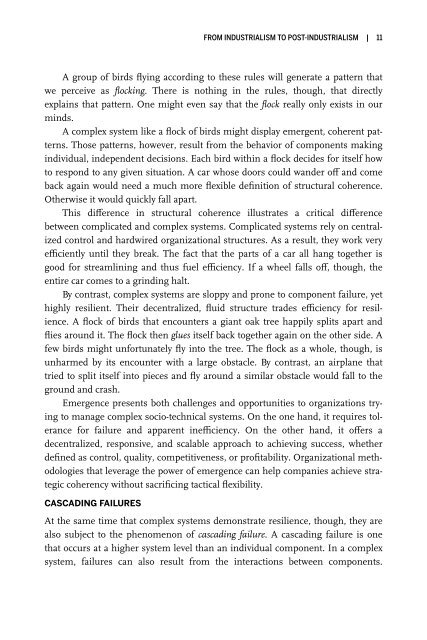Designing Delivery
1Tox6aC
1Tox6aC
You also want an ePaper? Increase the reach of your titles
YUMPU automatically turns print PDFs into web optimized ePapers that Google loves.
FROM INDUSTRIALISM TO POST-INDUSTRIALISM | 11<br />
A group of birds flying according to these rules will generate a pattern that<br />
we perceive as flocking. There is nothing in the rules, though, that directly<br />
explains that pattern. One might even say that the flock really only exists in our<br />
minds.<br />
A complex system like a flock of birds might display emergent, coherent patterns.<br />
Those patterns, however, result from the behavior of components making<br />
individual, independent decisions. Each bird within a flock decides for itself how<br />
to respond to any given situation. A car whose doors could wander off and come<br />
back again would need a much more flexible definition of structural coherence.<br />
Otherwise it would quickly fall apart.<br />
This difference in structural coherence illustrates a critical difference<br />
between complicated and complex systems. Complicated systems rely on centralized<br />
control and hardwired organizational structures. As a result, they work very<br />
efficiently until they break. The fact that the parts of a car all hang together is<br />
good for streamlining and thus fuel efficiency. If a wheel falls off, though, the<br />
entire car comes to a grinding halt.<br />
By contrast, complex systems are sloppy and prone to component failure, yet<br />
highly resilient. Their decentralized, fluid structure trades efficiency for resilience.<br />
A flock of birds that encounters a giant oak tree happily splits apart and<br />
flies around it. The flock then glues itself back together again on the other side. A<br />
few birds might unfortunately fly into the tree. The flock as a whole, though, is<br />
unharmed by its encounter with a large obstacle. By contrast, an airplane that<br />
tried to split itself into pieces and fly around a similar obstacle would fall to the<br />
ground and crash.<br />
Emergence presents both challenges and opportunities to organizations trying<br />
to manage complex socio-technical systems. On the one hand, it requires tolerance<br />
for failure and apparent inefficiency. On the other hand, it offers a<br />
decentralized, responsive, and scalable approach to achieving success, whether<br />
defined as control, quality, competitiveness, or profitability. Organizational methodologies<br />
that leverage the power of emergence can help companies achieve strategic<br />
coherency without sacrificing tactical flexibility.<br />
CASCADING FAILURES<br />
At the same time that complex systems demonstrate resilience, though, they are<br />
also subject to the phenomenon of cascading failure. A cascading failure is one<br />
that occurs at a higher system level than an individual component. In a complex<br />
system, failures can also result from the interactions between components.


